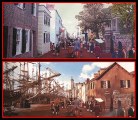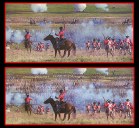.
CONTENTS:
INSIDE THE FX OF:
|
 |
THE PATRIOT
Produced by Roland Emmerich and Dean Devlin from a script by Robert Rodat this nuevo epic movie rivals some of the classics through the new digital technologies. These effects shots masterfully done by Centropolis Effects included 150 effects shots including 70 percent battle scenes. The other 30 percent included extending locations via matte paintings and model photography.
As Industrial Light & Magic performed in "PHANTOM MENACE", Centropolis did tests for the soldier replication by shooting effects plates outdoors, in natural sunlight and on battlefields as large as four square miles. "We didn't know at that point exactly how we were going to shoot the live action portion of the big battles" stated Robertson, "We had to figure out how much we needed to cover with the real soldiers, since we didn't know exactly how the CGI" (computer generated image) "soldiers would work. Then there was the question of recording camera positions on battlefields that were huge. We couldn't just go out there with a tape measure to gather tracking data. There were a lot of questions as we went into shooting."
Many actual Revolutionary War battle sites were used as the filming commenced in September 1999. Global positioning Satellite devices and LIDAR (a type of Laser radar) were used in gathering tracking data for these great distances. "Not only were these fields really big, they were relatively flat, so there weren't a lot of features to bounce a laser off of out there, very few hills or rocks or anything like that." Says Robertson.
The Charlestown establishing pan that looks up the street and with the carriage coming toward camera ending the pan looking down the street in the opposite direction was done almost entirely with miniatures. Joachim Gruninger, miniature effects supervisor on the project explains, "in that first view, everything after the first three houses was a miniature. The second view featured miniature ships on the left side of the frame and more miniature buildings on the right side. We replaced everything beyond one house in the foreground, all the way to the little white church at the end of the street. We shot the ships and the front most house together because the way the shot was set up, that foreground house would have been too close to camera for a 1/24 scale model. So we went with 1/12 for that first building. Everything else was 1/24 scale, shot in separate setups."
Gruninger says that, "We drew side and front views of the buildings in the computer and once that technical drawing was approved, we gave it to a company that does high pressure water cutouts of wood. That provided us with ready shapes from which we could make up our own house model kits. We put those basic shapes together, then we molded different types of exteriors and other bits of detailing; shingles, chimneys, shutters; cast them in resin and added them to the buildings. We drew all the windows and doors in the computer, then produced a positive model. From that we made a negative mold that we could use to cast windows and doors."
"All of the ships were 1/12 scale," according to Gruninger, "but there were different sizes for the sake of variety. That way we were able to populate the harbor shots with many sizes and types of ships. From the designs to the paint jobs, we avoided color schemes, lines or details that would identify the ships specifically as British or French. We also had guidelines as to how craftsmen of the period worked with wood and how they painted the ships. There was a lot of detailed information available to us, so that we could build the things correctly for the period."
The ship models were constructed out of pine and the keel cut first, then cross section beams placed along its length. Steamed wooden planks shaped the sides and wood glue held it all together. This was a lot like the way they built these ships during that period. The sails, fabric embedded with a glue and water mixture then dried in front of a wind machine to produce a stressed look. An airbrush created the dirt and stains in the sails. Ship details where cast in resin from silicon molds such as blocks, rope rigging, doors and navigational equipment these were made readily available for dressing.
The battle scenes were cumbersome, all the motion capture was done at HOUSE OF MOVES and like the PHANTOM MENACE, there where a library of moves recorded to apply to the digital models and then spread out into the battlefield plates.
CONTENTS:
COVER STORY:
in depth with Arnold for the 6th Day!
Special Make-up FX
with
Amalgamated Dynamics
Cinesite Creates Eerie Illusions For Lost Souls
Jim Healy Blows Things Up for DUNE
FX NEWS
|
NAVIGATION




